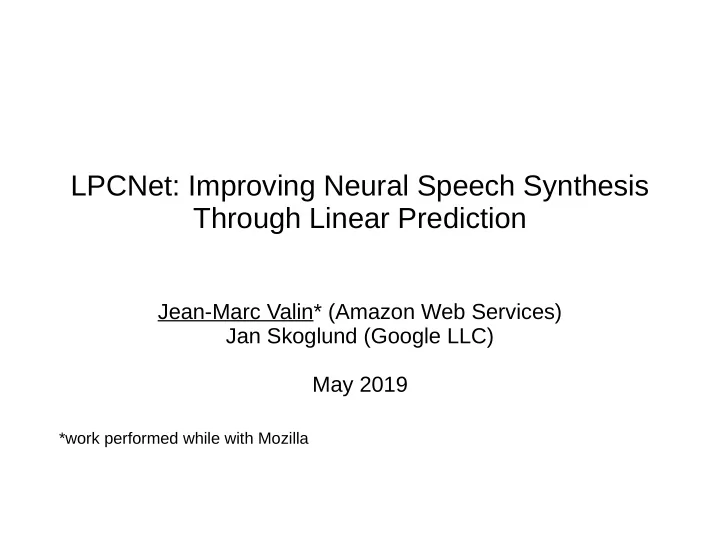

LPCNet: Improving Neural Speech Synthesis Through Linear Prediction Jean-Marc Valin* (Amazon Web Services) Jan Skoglund (Google LLC) May 2019 *work performed while with Mozilla
Approaches to Speech Synthesis ● “Old” DSP approach – Source-filter model – Synthesizing the excitation is hard – Acceptable quality at very low complexity ● New deep learning approach – Data driven – Results in large models (tens of MBs) – Very good quality at very high complexity ● Can we have the best of both worlds?
Neural Speech Synthesis ● WaveNet demonstrated impressive speech quality in 2016 – Data-driven: learning from real speech – Auto-regressive: each sample based on previous samples – Based on dilated convolutions – Probabilistic: network output is not a value but a probability distribution for μ-law value ● Still some drawbacks – Very high complexity (tens/hundreds of GFLOPS) – Uses neurons to model vocal tract
WaveRNN ● Replace dilated convolutions with RNN ● Addresses some of WaveNet’s issues
LPCNet: Bringing Back DSP ● Adding linear prediction to WaveRNN – Neurons no longer need to model vocal tract
Other Improvements ● Pre-emphasis – Boost HF in input/training data (1 – α z -1 ) – Apply de-emphasis on synthesis – Attenuates perceived μ-law noise for wideband ● Input embedding – Rather than use μ-law values directly, consider them as one-hot classifications – Learning non-linear functions for the RNN – Can be done at no cost by pre-computing matrix products
LPCNet: Complete Model
Training ● Inputs: signal ( t -1), excitation ( t -1), prediction ( t ) ● Output: excitation probability ( t ) ● Teacher forcing: use clean data as input – Need to avoid diverging due to imperfect synthesis not matching (perfect) training data – Inject noise in the input data – excitation = (clean signal) – (noisy prediction) ● Pre-emphasis and DC rejection applied to input ● Augmentation: varying gain and response
Complexity ● Use 16x1 block sparse matrices like WaveRNN – Add diagonal component to improve efficiency – 10% non-zero coefficients – 384-unit sparse GRU equivalent to 122-unit dense GRU ● Total complexity: 3 GFLOPS – No GPU needed – 20% of one 2.4 GHz Broadwell core – Real-time on modern phones with one core
Results ● Demo: https://people.xiph.org/~jm/demo/lpcnet/
Applications ● Text-to-speech (TTS) ● Low bitrate speech coding ● Codec post-filtering ● Time stretching ● Packet loss concealment (PLC) ● Noise suppression
Conclusion ● Bringing back DSP in neural speech synthesis – Improvement on WaveRNN – Easily real-time on a phone ● Future improvements – Use parametric output distribution – Add explicit pitch (as attention model?) – Improve noise robustness
Questions? ● LPCNet source code (BSD) – https://github.com/mozilla/lpcnet/
Recommend
More recommend